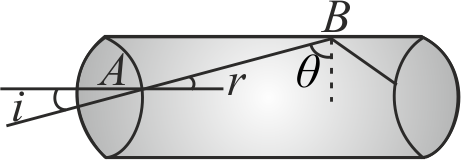Explanation:
Let a light ray enters at \(A\) and
refracted beam is \(A B\). At the lateral
face, the angle of incidence is \(\theta\). For no
refraction at this face, \(\theta > C.\)
\(i.e.\,\,\,\,\,\,\,\,\,\sin \theta > \sin C\)
but \(\,\,\,\,\,\,\,\theta + r = {90^ \circ } \Rightarrow \theta = {90^ \circ } - r\)

\(\therefore \,\,\,\,\,\,\,\,\,\,\,\,\sin \left( {{{90}^ \circ } - r} \right) > \sin C\)
\({\rm{or}}\,\,\,\,\,\,\,\,\,\,\cos r > \sin C\,\,\,\,\,\,\,\,\,\,\,\,\,\,\,\,\,\,\,\,\,\left( 1 \right)\)
By snell's law,\(\,\,\,\,\,\,\,\,\,\,\,\,{\kern 1pt} n = \frac{{\sin i}}{{\sin r}}\)
\( \Rightarrow \,\,\,\,\,\,\,\,\,\,\sin r = \frac{{\sin i}}{n}\)
\(\therefore \;\;\;{\mkern 1mu} {\kern 1pt} \cos r = \sqrt {1 - {{\sin }^2}r} = \sqrt {\left( {1 - \frac{{{{\sin }^2}i}}{{{n^2}}}} \right)} \)
From Eq. (1), \(\sqrt {1 - \frac{{{{\sin }^2}i}}{{{n^2}}}} > \sin C\)
Also, \(\,\,\,\,\,\,\,\,\sin C = \frac{1}{n}\)
\( \Rightarrow \,\,\,\,\,\,\,\,1 - \frac{{{{\sin }^2}i}}{{{n^2}}} > \frac{1}{{{n^2}}}\)
or \(\,\,\,\,\,\,\,\,{n^2} > {\sin ^2}i + 1\)
The maximum value of \(\sin i\) is 1.
\( \Rightarrow \,\,\,\,\,\,\,\,{n^2} > 2\,{\rm{or}}\,n > \sqrt 2 \)